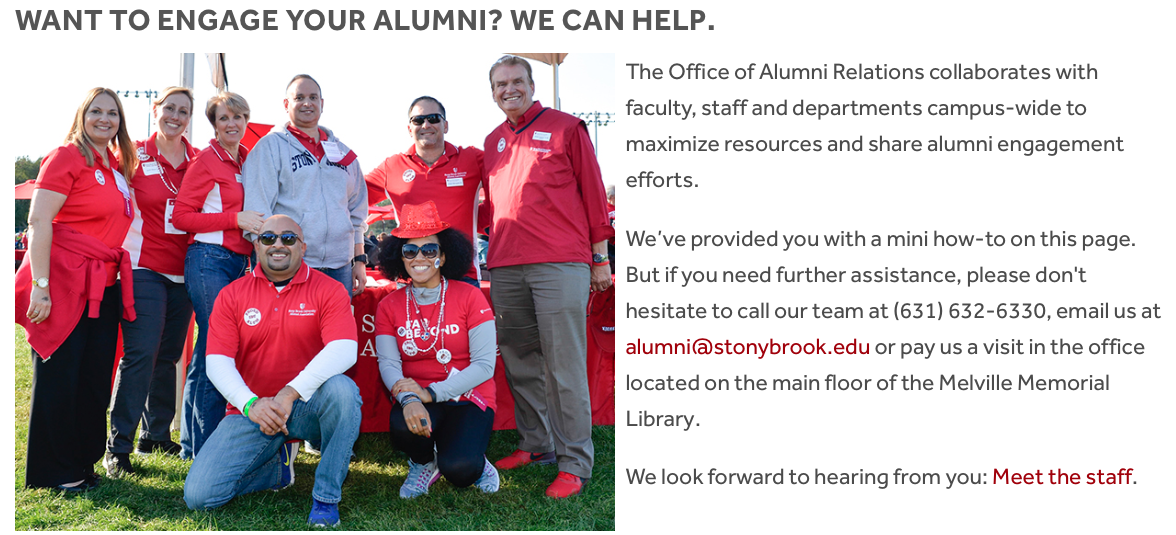It is hard to meaningfully engage large, diverse groups of alumni. Many institutions devote limited resources to alumni engagement teams yet expect them to meet the growing demands from alumni to receive continued support from the institution after graduation.
One of the best ways to meet diverse alumni needs with limited staff and resources is to create campus partnerships with other offices that interact with alumni to form a united front.
Amid growing demands and shrinking resources, Stony Brook University Executive Director of Alumni Relations Matthew Colson and his team have done an amazing job expanding their reach to better support more than 180,000 alumni worldwide. Matthew and his team are an engagement arm and pipeline for the advancement team who share in their vision for building campus partnerships to better engage more alumni. Matthew’s team has met with as many campus partners as possible to create a culture on campus that recognizes expanding alumni engagement as an institutional priority.
Matthew Colson
Matthew and his team speak with internal partners to ensure they felt heard and supported. Matthew understands that higher education professionals in general are strapped for time and often overworked. He knows it is important to work across institutional silos and equip people with the resources they need to engage alumni without competing with their own departmental priorities. Throughout the team’s conversations with internal partners, their goals are listening, understanding their departmental needs and goals, and connecting them to resources that could support their efforts. Through this approach, Matthew’s team finds various campus partners to create a web of institutional messengers prepared to engage alumni.
At the same time, Matthew and his team are careful to keep their eye on Stony Brook’s advancement goals. Each time they assist colleagues in other offices, they ask themselves, “Why are we doing this? What are we going to accomplish? Why are alumni better off for doing this after we are done.” Matthew and his team always remained focused on the alumni relations team's goals even as they help others achieve theirs.
Here are three key components to Stony Brook’s strategy:
Create the toolkit: Stony Brook’s website features an alumni engagement toolkit for faculty and staff: Alumni Engagement 101. On this page, faculty and staff find everything they need out of the box to start engaging alumni in ways that fit their department. Matthew and his team explain how they can help departments across campus bring in alumni speakers, host alumni on campus, and run alumni communications campaign. They also make it clear what they need from campus partners in order to be effective.
Brand the alumni engagement team internally as professional experts and a resource: What impresses me most about Matthew’s approach is how he empowers his team to engage campus partners in discovery meetings and works to brand all team members as supporters who are informed and capable of helping partners engage alumni. He lets members of his team lead meetings and presentations on behalf of the office and delegates work to them that was traditionally the responsibility of the executive director. In doing so, Matthew has eliminated the hierarchical culture that too often gets in the way of breaking down silos.
Start every conversation with, “What do you want to accomplish?”: The Stony Brook team meets various campus partners where they are and forges alumni engagement opportunities that are tweaked to align with shared priorities. Again, nothing is custom-created from scratch, everything can be linked back to the original tool kit, but each department feels heard and helped after collaborating with the Stony Brook team. In each conversation, team members are prepared to listen, conduct a basic needs assessment, and connect campus partners to the information and resources they need.
Of course, not every attempt to work through silos goes smoothly. When people are reluctant to commit to a partnership, Matthew and his team don't push it. They wanted to help their campus partners succeed, and that means both sides need to buy in. At the same time, Matthew’s team never closes the door on partnerships. Successful collaborations set the example for skeptical colleagues and win them over down the line.
Matthew knew his strategy was working when he began to hear campus partners say it was a pleasure to work with his team and that the outcome was better than they imagined would be. Because he trusts and empowers his team to work with others, their colleagues across campus can see the level of the team’s expertise and vision.



